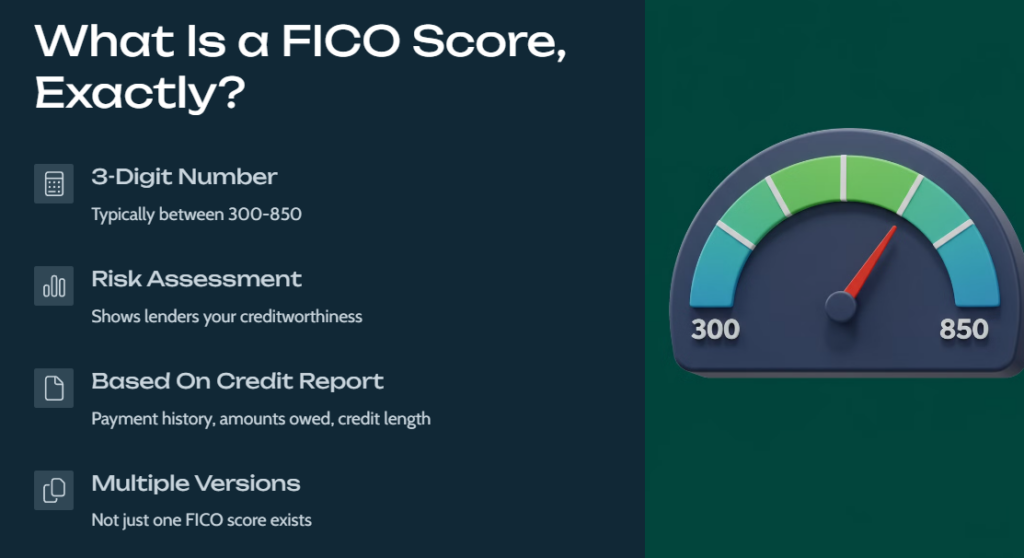Have you ever checked your credit score from your bank, then looked at the one from your credit card — only to see two different numbers?
You’re not alone. In fact, it’s perfectly normal.
Here’s why your FICO score isn’t the same everywhere, and how to understand what really matters when you’re keeping track of your credit.
Part of the Series: Best Strategies for your Credit!
How to Improve Your Credit Score
├─ 10 Proven Boost Your Credit Score Strategies
├─ How to Build Credit with No History: Effective Steps
├─ How to Get Free Annual Credit Report in 3 Steps
├─ Best Secured Credit Cards for Beginners
├─ How Credit Utilization Affects Your Score
├─ Why Is Your FICO Score Different from Bank to Credit Card? [Current Article]
└─ How Late Payments Affect Your Score
What Is a FICO Score, Exactly?
Your FICO score is a 3-digit number (typically between 300 and 850) that lenders use to estimate how risky it would be to lend you money. It’s based on your credit report, which includes your:
- Payment history
- Amounts owed
- Length of credit history
- Types of credit
- New credit inquiries
But here’s the catch — there isn’t just one FICO score. That’s the first reason you might see different numbers.

Reason 1: There Are Multiple Versions of FICO Scores
Yes, really — FICO has created dozens of versions of its scoring model. Here are some of the most common ones:
- FICO Score 10: Newly released version that incorporate recent consumer behavior and trended data to provide a more accurate assessment of credit risk.
- FICO Score 9: The model treats medical debt more leniently
- FICO Score 8: The most widely used version for general lending
- FICO Auto Score: Used specifically for car loans
- FICO Bankcard Score: Tailored for credit card issuers
- FICO Score 2, 4, and 5: Still used in mortgage lending
Each version weighs credit factors a little differently, which is why your score can vary depending on which one a lender (or app) uses.
| Experian | Equifax | TransUnion |
| Widely used versions | ||
| FICO® Score 9 FICO® Score 8 | FICO® Score 9 FICO® Score 8 | FICO® Score 9 FICO® Score 8 |
| Versions used in auto lending | ||
| FICO® Auto Score 9 FICO® Auto Score 8 FICO® Auto Score 2 | FICO® Auto Score 9 FICO® Auto Score 8 FICO® Auto Score 5 | FICO® Auto Score 9 FICO® Auto Score 8 FICO® Auto Score 4 |
| Versions used in credit card decisioning | ||
| FICO® Bankcard Score 9 FICO® Bankcard Score 8 FICO® Score 3 FICO® Bankcard Score 2 | FICO® Bankcard Score 9 FICO® Bankcard Score 8 FICO® Bankcard Score 5 | FICO® Bankcard Score 9 FICO® Bankcard Score 8 FICO® Bankcard Score 4 |
| Versions used in mortgage lending | ||
| FICO® Score 2 | FICO® Score 5 | FICO® Score 4 |
| Newly released version | ||
| FICO® Score 10 FICO® Auto Score 10 FICO® Bankcard Score 10 FICO® Score 10T | FICO® Score 10 FICO® Auto Score 10 FICO® Bankcard Score 10 FICO® Score 10T | FICO® Score 10 FICO® Auto Score 10 FICO® Bankcard Score 10 FICO® Score 10T |
Reason 2: Different Credit Bureaus, Different Data
There are three major credit bureaus in the U.S.:
Your credit report isn’t identical at all three — some lenders only report to one or two bureaus, not all three. So if your bank pulls from Experian, and your credit card uses TransUnion, they might be working off different information.
Result? Different FICO scores.
Want even more about Credit Bureaus?
👉 Check out our Free Annual Credit Report article.
Reason 3: Timing of Updates Matters
Even if two services are using the same version of FICO and the same credit bureau, they might be pulling the data at different times.
For example:
- Your credit card company updates your account to the credit bureaus at the end of each billing cycle
- A bank pulls your score when you apply for credit, such as a loan or credit card, or when managing existing credit accounts, to assess your creditworthiness and risk
→ The bank doesn’t see your most recent payment, and your score appears lower
Credit reports change constantly — even a few days can make a difference.
Reason 4: You Might Be Seeing a VantageScore Instead
Some credit card apps and free monitoring tools don’t show your FICO score at all — instead, they show your VantageScore, which is a different scoring model developed by the credit bureaus themselves.
- VantageScore uses a similar 300–850 scale
- It weighs some credit factors differently
- It may update more frequently in some tools
If you’re comparing a FICO score from your bank to a VantageScore from your credit card app, you’re not comparing apples to apples.
So… Which Score Should I Trust?
It depends on what you’re using it for.
- If you’re applying for a mortgage, lenders usually use older FICO versions (like FICO Score 2, 4, or 5)
- For credit cards or personal loans, it’s often FICO Score 3 or FICO Bankcard Score
- If you’re just tracking your credit health, any score is helpful — but FICO is what most lenders rely on
📌 Pro tip: If you’re applying for a specific loan, ask the lender which version of FICO and which bureau they use. That’ll help you know where to focus.

Key Takeaways: Why Your FICO Scores Vary
| Reason | What It Means |
|---|---|
| Multiple versions | Different scores for different lenders (FICO 8, 9, Bankcard, etc.) |
| Different credit bureaus | Not all lenders report to all bureaus |
| Different update timing | Scores reflect credit activity at different moments |
| VantageScore vs. FICO | Different scoring models show different results |
If your FICO score looks different depending on where you check, don’t stress — it’s completely normal. The important thing is to check it regularly, understand what affects it, and use tools that give you a consistent picture over time.
As long as you’re paying bills on time, keeping balances low, and avoiding too many new accounts, your credit will continue to head in the right direction — no matter which number you’re seeing today.


